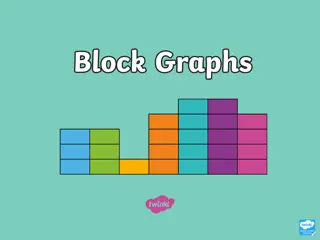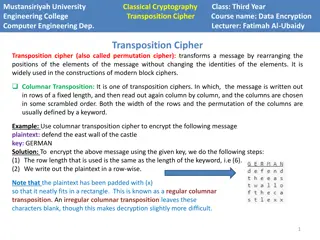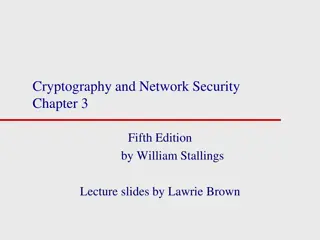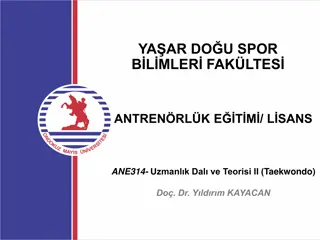Understanding DES Block Cipher in Computer Engineering at Mustansiriyah University
Data Encryption Standard (DES) is a widely used algorithm for encrypting data in 64-bit blocks with a 56-bit key. This course at Mustansiriyah University covers the key components of DES, including the key schedule, round function, and initial/final permutation. Students learn about the encryption process involving steps like initial permutation, key mixing, substitution using S-boxes, and permutation. Dr. Fatimah Al-Ubaidy leads the course, teaching students the intricacies of DES block cipher and its applications in computer engineering.
- DES Block Cipher
- Data Encryption Standard
- Computer Engineering
- Mustansiriyah University
- Dr. Fatimah Al-Ubaidy
Download Presentation

Please find below an Image/Link to download the presentation.
The content on the website is provided AS IS for your information and personal use only. It may not be sold, licensed, or shared on other websites without obtaining consent from the author. Download presentation by click this link. If you encounter any issues during the download, it is possible that the publisher has removed the file from their server.
E N D
Presentation Transcript
Mustansiriyah University Engineering College DES Block Cipher Computer Engineering Dep. Lecturer: Dr. Fatimah Al-Ubaidy Block Cipher Class: Third Stage Course name: Data Encryption DES Block Cipher The Data Encryption Standard (DES): This algorithm adopted in 1977 by the National Institute of Standards and Technology (NIST). The algorithm itself is referred to as the Data Encryption Algorithm (DEA). For DES, data are encrypted in 64-bit blocks using a 56-bit key. The algorithm transforms 64-bit input in a series of steps into a 64-bit output. The same steps, with the same key, are used to reverse the encryption. DES encryption algorithm: The general structure of the DES consists of (1) key schedule, (2) round function and (3) initial and final permutation. Step1: Plaintext is broken into blocks of length 64 bits. Step2: The 64-bit block undergoes an initial permutation (IP) using initial permutation IP table, IP(M). Step3: The 64-bit permuted input is divided into two 32-bit blocks: left (L) and right (R). The initial values of the left and right blocks are denoted L0and R0. Step4: There are 16 rounds of operations on the L and R blocks. During each round, the following formula is applied: Ln= Rn-1 Rn= Ln-1XOR F(Rn-1,Kn) 1
Mustansiriyah University Engineering College DES Block Cipher Computer Engineering Dep. Lecturer: Dr. Fatimah Al-Ubaidy Block Cipher Class: Third Stage Course name: Data Encryption DES Block Cipher Step5: The function F(.) represents the heart of the DES algorithm. This function implements the following operations: 1-Expansion: The right 32-bit half-block is expanded to 48 bits using the expansion permutation (E) table, E(Rn-1). 2-Key mixing: The expanded result is combined with a subkey using an XOR operation. Sixteen 48-bit subkeys (one for each round) are derived from the main key using the key schedule, Kn+ E(Rn-1). 3-Substitution: After mixing in the subkeys, the block is divided into eight 6-bit pieces and fed into the substitution boxes (S-boxes), which implements nonlinear transformation. Each 6-bit piece uses as an address in the S-boxes where the first and last bits are used to address the ith row and the middle four bits to address the jth column in the S-boxes. The output of each S-box is 4-bit length piece. The output of all eight S-boxes is then combined into 32 bit section. Kn+ E(Rn-1) = B1B2B3B4B5B6B7B8 S(Kn+ E(Rn-1)) = S1(B1)S2(B2)S3(B3)S4(B4)S5(B5)S6(B6)S7(B7)S8(B8) 4-Permutation: The 32 bits outputs from the S-boxes are rearranged using the P-box, F=P(S(Kn+ E(Rn-1))) Step6: The results from the final DES round (i.e., L16and R16) are recombined into a 64-bit value and rearranged using an inverse initial permutation (IP-1) table. The output from IP-1is the 64-bit ciphertext block. 2
Mustansiriyah University Engineering College DES Block Cipher Computer Engineering Dep. Lecturer: Dr. Fatimah Al-Ubaidy Block Cipher Class: Third Stage Course name: Data Encryption Expansion E-box Single Round function (F) of the DES DES Encryption Flowchart 3
Mustansiriyah University Engineering College DES Block Cipher Computer Engineering Dep. Lecturer: Dr. Fatimah Al-Ubaidy Block Cipher Class: Third Stage Course name: Data Encryption Tables used in the DES algorithm 4
Mustansiriyah University Engineering College DES Block Cipher Computer Engineering Dep. Lecturer: Dr. Fatimah Al-Ubaidy Block Cipher Class: Third Stage Course name: Data Encryption DES Block Cipher Key schedule (generator): This algorithm generates the subkeys (K 1- The 56 bits of the key are selected from the initial 64 by Permuted Choice 1 (PC1) table. K1, K2 K16). 28 bits 56 bits 2- The 56 bits are divided into two 28-bit halves. 3- In each round, both halves are rotated left by one or two bits (specified for each round). 4- The 48 subkey bits are selected by Permuted Choice 2 (PC2) table (24 bits from the left half, and 24 from the right) and used in each round. General remarks in the DES: 1- The S-boxes provide the core of the security of DES and the cipher would be linear, and trivially breakable without them. Key schedule structure 2- The substitution and permutation in the DES provide confusion and diffusion. 5
Mustansiriyah University Engineering College DES Block Cipher Computer Engineering Dep. Lecturer: Dr. Fatimah Al-Ubaidy Block Cipher Class: Third Stage Course name: Data Encryption The DES S-Boxes Tables used in DES key generator 6
Mustansiriyah University Engineering College DES Block Cipher Computer Engineering Dep. Lecturer: Dr. Fatimah Al-Ubaidy Block Cipher Class: Third Stage Course name: Data Encryption Application of S-box in DES Algorithm 7
Mustansiriyah University Engineering College DES Block Cipher Computer Engineering Dep. Lecturer: Dr. Fatimah Al-Ubaidy Block Cipher Class: Third Stage Course name: Data Encryption DES Block Cipher DES decryption : The decryption algorithm uses the same steps exactly as in the encryption algorithm except that the application of the subkeys is reversed (i.e. in round1 use K16, round2 use K15 and so on). Security and cryptanalysis: The two most widely used attacks on block ciphers are linear and differential cryptanalysis. DES is also vulnerable to a brute-force (exhaustive search) attack. Triple DES: In cryptography, Triple DES (3DES or TDES), officially the Triple Data Encryption Algorithm (TDEA or Triple DEA), is a symmetric-key block cipher, which applies the DES cipher algorithm three times to each data block. Therefore, Triple DES uses a "key bundle" that comprises three DES keys, , each of 56 bits. The encryption algorithm is: That is, DES encrypt with , DES decrypt with , then DES encrypt with . Decryption is the reverse: That is, decrypt with , encrypt with , then decrypt with . Each triple encryption encrypts one block of 64 bits of data. 8























